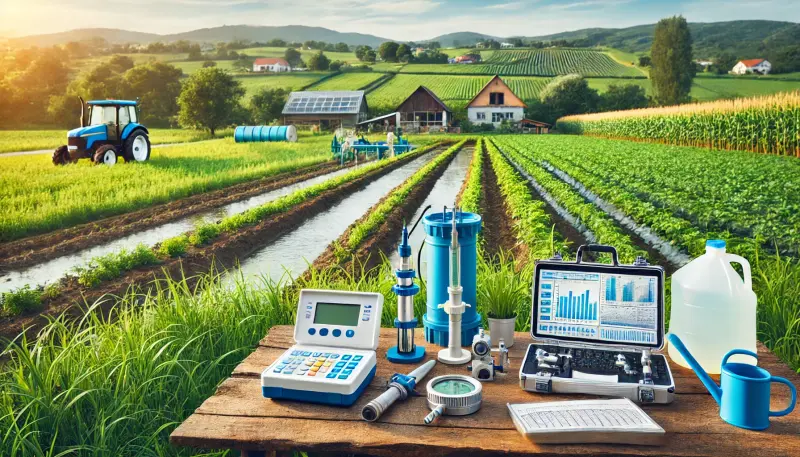Groundwater Quality Analysis Devices in Rural Areas: Supporting Sustainable Agricultural Development
In many rural areas, agriculture plays a crucial role in sustaining the local economy and community. However, the efficiency and productivity of farming operations are often tied to the quality of the available water resources. Groundwater, which serves as a primary source of irrigation in many agricultural regions, can be susceptible to contamination from various natural and human-made factors. Consequently, ensuring the quality of groundwater is vital for sustaining agricultural practices and protecting the environment. This is where advanced devices for analyzing groundwater quality come into play.
The Importance of Groundwater Quality in Agriculture
Water is essential for agricultural production, with proper irrigation being necessary for the growth of crops and the health of livestock. Groundwater, typically stored in underground aquifers, is a critical source of water for rural areas, especially in regions where surface water sources are scarce or unreliable. Groundwater quality directly impacts crop yields, the viability of livestock farming, and, ultimately, the livelihoods of farmers. Contaminants such as heavy metals, chemicals, excessive salinity, or bacteria can degrade water quality, making it unsafe for irrigation and drinking purposes.
The agricultural sector is particularly vulnerable to fluctuations in water quality because crops and animals are directly affected by the water they consume. For instance, poor-quality water can lead to soil salinization, reduced crop productivity, and even the death of plants. Livestock might also suffer from waterborne diseases if the water is contaminated, leading to increased veterinary costs and reduced milk and meat production. Thus, monitoring and maintaining the quality of groundwater is crucial to ensuring the long-term success of agricultural practices.
The Role of Groundwater Quality Analysis Devices
To address these concerns, the development and use of groundwater quality analysis devices have become an integral part of modern agricultural management. These devices allow farmers to monitor the quality of the groundwater they are using for irrigation, ensuring that it meets the required standards for healthy crop and livestock production. The role of these devices extends beyond just testing water; they help support sustainable farming practices, minimize resource waste, and safeguard the environment.
Modern groundwater analysis devices utilize advanced technology to detect a wide range of contaminants and provide real-time data on the water's quality. Some of the most commonly monitored parameters include pH levels, salinity, dissolved oxygen, nitrates, and the presence of harmful chemicals such as pesticides and fertilizers. By regularly testing these factors, farmers can identify potential problems before they have a significant impact on crops and livestock. This proactive approach helps to reduce the risk of crop failure, contamination of soil, and other environmental concerns.
Types of Devices Used for Groundwater Quality Analysis
There is a wide variety of devices and technologies available for groundwater analysis, each suited to different needs and levels of sophistication. The most basic devices provide simple readings of key parameters like pH and salinity, while more advanced models can analyze multiple contaminants at once and offer detailed insights into water quality.
1. Portable Water Test Kits
Portable water test kits are among the most common and affordable tools used in rural areas for basic groundwater quality testing. These kits are user-friendly and allow farmers to conduct quick, on-site tests. They typically include a set of color-coded test strips or reagents that change color in response to specific contaminants. While portable kits are not as precise as laboratory tests, they are sufficient for routine monitoring and immediate decision-making.
2. Sensors and Real-Time Monitoring Systems
For more advanced applications, sensors and real-time monitoring systems have become increasingly popular. These systems can be installed directly in wells or irrigation systems to provide continuous monitoring of water quality. They detect a range of parameters, including pH, turbidity, temperature, dissolved oxygen, and chemical contamination. The data is transmitted to a central system, where it can be analyzed and interpreted. Farmers can receive alerts when water quality deviates from acceptable standards, allowing them to take corrective action immediately.
3. Automated Sampling Systems
Automated sampling systems offer even greater precision in groundwater quality analysis. These systems automatically collect water samples at scheduled intervals, reducing the need for manual intervention. Once collected, the samples are analyzed in laboratories, where more in-depth tests are conducted. These systems are highly accurate and are often used by large-scale farms and agricultural research centers to monitor groundwater quality over time.
4. Remote Sensing and Satellite Technology
In some cases, remote sensing technologies such as satellites and drones are used to assess groundwater quality. These technologies offer a broader, landscape-level perspective of water resources. While they may not provide real-time data on groundwater quality, they can help track large-scale trends and changes in water availability and quality, especially in remote areas. Combining remote sensing data with ground-based analysis devices allows for a more comprehensive understanding of groundwater resources.
Supporting Sustainable Agricultural Practices
The integration of groundwater quality analysis devices into agricultural operations supports sustainability in several ways. By monitoring water quality, farmers can optimize irrigation practices, reducing water waste and ensuring that water resources are used efficiently. Over-extraction of water from groundwater reserves, which can lead to aquifer depletion, is another concern. Monitoring groundwater levels and quality helps prevent overuse and ensures that the water supply remains sustainable for future generations.
Moreover, these devices assist in minimizing the use of harmful chemicals in agriculture. By identifying the presence of pollutants, farmers can adjust their practices, such as reducing the application of fertilizers or pesticides, which can otherwise leach into the groundwater. This contributes to both environmental protection and cost reduction.
In conclusion, the development and implementation of devices for analyzing groundwater quality have proven to be indispensable in the modern agricultural landscape. These tools not only protect the environment but also help ensure that rural communities can continue to thrive by maintaining healthy, productive farming operations. As agricultural practices become more data-driven and technologically advanced, these devices will play an even greater role in achieving long-term sustainability and resilience within the agricultural sector.
